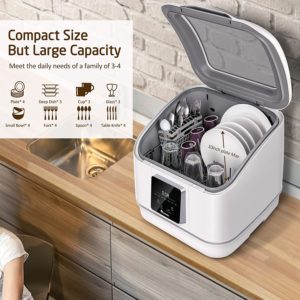Originally Created on: May 4, 2022 @ 5:30 pm
Why does my new dishwasher have water in it? If this is your worry, you are not alone and its not only your dishwasher. Most homeowners encounter this mystery when they purchase a new dishwasher. A dishwasher is an important home appliance that also doesn’t come cheap, so do everything to ensure the value of your money.
Meanwhile, it’s reasonable to assume that you have done your homework task before purchasing the dishwasher. You have done the research, analyzed the options, and when you finally get one you inspect various things before you even power on.
One peculiar thing you face is some water dripping. Fortunately, there is nothing to worry about as this article will explain the reason behind that observation. Let’s get straight to it.
Table of Content
Why Does My New Dishwasher Have Water In It
Brand new dishwashers have water in them mostly due to testing before shipping. Manufacturers test each and every dishwasher to ensure no malfunctioning appliances are delivered to client. It is perfectly normal for brand new dishwashers to have water in them.
Some homeowners often wonder why their new dishwasher has water in it, leaving them wondering if their dishwasher needs a drain or something. Well, it is very ok, and if your dishwasher doesn’t have water, you should make proper scrutiny of your appliance’s functionality.

Portable Countertop Dishwasher
Get value for your money!
- Large Capacity
- 7 Wash Cycle Options
- Anti-Leakage
- Practical Design
Practically, every dishwasher is tested at the retail store before shipping, this is necessary to ensure no malfunctioning appliance delivered to the client. Shipping a dishwasher that with technical issues not only cost the company transit to the client and return expenses but also raises eyebrows to prospective buyers.
So to protect the reputation of the brand and create trust, dishwasher manufacturer does the pre-testing before shipping. This is why you probably notice some water in your new dishwasher, tested and cleaned before the retail display. In addition, the technical staff at the shop may have not allowed all the water oose and dry after testing before packing.
You May Also Like: Why Does My Dishwasher Leave Brown Marks on Cutlery + 3 Tips
Actions to Take When You Buy a New Dishwasher
Apart from water drops, please do the following steps before using it for your cleaning needs whenever you receive your newly ordered dishwasher.
- Firstly, ensure its salt container is full and the lid is replaced securely. Salt is useful by the machine, you may add some if not full.
- Don’t assume the aid dispenser is clean. Rinse the aid dispenser well to ensure there isn’t any contamination that may affect you in any way especially since you’ll be washing dish-wares.
- Check for any industrial remains like specs, particles or metallic fillings. This may not be visible but you can wipe carefully.
- Also, remove the remains of the tape used when packing.
- Avoid disposing of the small caps that cover the screw if you are not informed on how to remove it.
These may be small things but they are equally important as they ensure your dishwasher is clean and hygienic before you start using it.
Make sure the detergent drawer is filled to the top. If not, add some detergent inside it and install it in place. Your new dishwasher should be connected to the water supply and electricity, then press the power button to start the machine.
Related: Can I Take a Shower While The Dishwasher is Running?
Is It Normal For A New Dishwasher To Have Water In The Bottom?
Definitely yes, it’s very normal to find some water at the bottom of your dishwasher on arrival. During testing or normal usage, some little water, up to 2 cups, may remain at the bottom. A small amount of water remaining after every cycle is useful as it keeps the seals from drying up, which attracts rust.
Although also a dishwasher comes with protective coatings that protect it from rust and prevents reaction with salt and water.
Is it normal for a new dishwasher to have water in the bottom? The answer is simple, ask yourself, how much water? In case a lot of water remains at the bottom whenever you run, you have a reason to get worried so long as the air gap is correctly installed.
To check, you need to remove the bottom panel. Most dishwashers have a removable panel on the bottom, which is quite easy. Typically the drain is placed in a little channel at the dishwasher bottom, and the unit will have this flap at the back. Yank it straight and move it out a little from its slot to open it. You may feel some resistance due to some friction but take it out easily.
You May Also Like: Can I Run My Dishwasher with Cold Water (Surprising Facts!)
Are All Dishwasher Brands Wet When New?
Yes and no! It depends on how much the brand values quality assurance. Every brand ensures the dishwashers are tested at the factory before delivering or shipping to the buyer. If you open and don’t see a sign of water, there was no testing, but still, since the model has a warranty, you can return for replacement if it isn’t functioning right.
Meanwhile, when you buy your dishwasher from the brand, direct chances are high; it will be wet for testing and prevent drying up of parts or draining hose. Moreover, the water should be very little because the gap facilitates the drainage. The air gap should be properly installed, or it won’t allow air in, thus creating a vacuum.
Regardless of the manufacturer, a dishwasher with a blocked or clogged air gap will have excess water remaning at the bottom.
Editor’s Pick: Why is my dishwasher making a clunking noise? (3 Key Reasons Why)
Conclusion
Hopefully, this article answers the question ‘why does my new dishwasher have water in it and helps you know having little water at the bottom is rather normal.
Additionally, if you check the unit and find it missing the air gap or is blocked with dirt, ask for a replacement. You can always read the manufacturer’s manual for the setting of that appliance. Thanks for reading!

